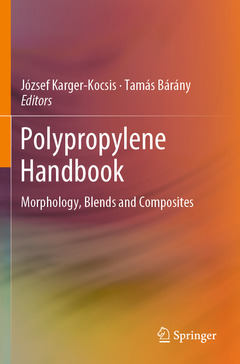Description
Polypropylene Handbook, 1st ed. 2019
Morphology, Blends and Composites
Coordinators: Karger-Kocsis József, Bárány Tamás
Language: English
Subject for Polypropylene Handbook:
Keywords
Polypropylene homo- and copolymers; Polypropylene polymorphism; Polypropylene processing-induced morphology; Polypropylene nucleation; Polypropylene melting/crystallization; Self-reinforced polypropylene; Polypropylene foam(s); Structure-property-processing relationships; Applications of PP
Publication date: 10-2020
Support: Print on demand
Publication date: 03-2019
641 p. · 15.5x23.5 cm · Hardback
Description
/li>Contents
/li>Biography
/li>Comment
/li>
József Karger-Kocsis (Mar 4, 1950 - Dec 13, 2018) was a professor at the Department of Polymer Engineering, Faculty of Mechanical Engineering at the Budapest University of Technology and Economics (BME) since 2009. He received his MSc in Chemical Engineering in 1974, and his Dr.techn. in 1977. In 1983 he received his PhD in chemical sciences from the Moscow, Lomonossow Institute of Fine Chemicals Technology, his DSc from the Hungarian Academy of Sciences in 1991, and in 1995 the Universität Kaiserslautern, Germany, granted him the Dr.-Ing. Habil title.
During his career he also worked at the Research Institute for the Plastics Industry, and Taurus Hungarian Rubber Works, both in Budapest, Hungary; for the TUHH in Hamburg and for the Institute for Composite Materials in Kaiserslautern, both in Germany; and for the Tshwane University of Technology in Pretoria, South Africa.
Professor Karger-Kocsis has been awarded many prizes, acknowledgements and scholarships, and has more than 500 publications. For his complete CV please refer to the Budapest University of Technology and Economics (the website of the Department of Polymer Engineering, BME).
Tamás Bárány is associate professor of the Department of Polymer Engineering, the Faculty of Mechanical Engineering at the Budapest University of Technology and Economics (BME). He received his MSc in Industrial Design Engineering in 2001. Subsequently, he received his PhD and became a lecturer in 2004, an assistant professor in 2005, and since 2008 he has been holding the position of associate professor and head of the Department of Polymer Engineering.
He, too, has been awarded many prizes, acknowledgements and scholarships, and he has more than 80 publications. He is busily involved in tutorial activities, writing articles and organizing conferences.For his complete CV please refer to the Budapest University of Technology and Economics (the website of the Department of
Offers a comprehensive, updated overview of polypropylene-related systems
Focuses on processing-structure-property relationships
Critically assesses existing explanations, descriptions, modeling theories and approaches

